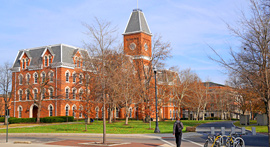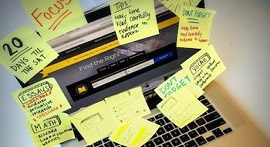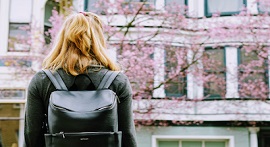We are Union, and we are true to our name. Founded in 1795 as the first planned campus in the United States, Union College is a highly selective, private, residential, liberal arts college with engineering that is consistently ranked among the nation's top colleges. Set on 100 acres in downtown Schenectady, N.Y., including eight acres of formal gardens and woodland, Union is within easy reach of New York City, Boston, Montreal, rural areas and outdoor recreation. Here, tradition meets innovation across the arts, engineering, humanities, sciences and social sciences. Union's flexible academic structure encourages students to study across disciplines and pursue what intrigues them. Its innovative curriculum and world-class facilities emphasize collaboration with students and faculty through small class sizes, research in all disciplines, internships and international study.
About
From the School
Contact & Visit
Campus Visits Contact
Director of Admissions for Programming and Partnerships
Grant Hall
Schenectady, NY 12308
Experience College Life
Schaffer Library
Reamer Campus Center
Jackson's Garden
Wold Center for Science and Engineering
Jay Street area - restaurants, shops
MVP Arena - sporting events, concerts
Crossgates Mall
Adirondack Mountains
Located in the Capital District of New York, Schenectady boasts the amenities of a small city and the recreational opportunities of the Adirondack and Berkshire mountains.
Campus Tours
9:00am-4:00pm; 10am-2pm
(518) 388-6112
Dates: Year-round
Times: Mon-Fri 10:30am, 12:30,1:30,&3:30pm,some Sat. 11am,noon,1pm
Average Length: 1 hour
On Campus Interview
Faculty and Coach Visits
Class Visits
Overnight Dorm Stays
Transportation
Admissions
Admissions
Overall
From The School
For more information on application requirements and deadlines, head to Union College's Admissions website at this link.
Overview
GPA Breakdown
Need to boost your grades? We can help.
Learn MoreSAT & ACT Test Scores
Testing Policies
Deadlines
Early Decision — November 1
Early Decision II — January 15
Early Action — November 1
Regular — January 15
Other Admission Factors
Rigor of Secondary School Record
Class Rank
Academic GPA
Selectivity Rating
Get a personalized plan for a competitive application from an admissions expert.
Learn MoreAcademics
Academics
Overall
From The School
Academic Programs
Africana Studies
American Studies
Anthropology
Art History
Asian Studies
Astronomy
Astrophysics
Biology
Biomedical Engineering
Biochemistry
Chemistry
Chinese
Civil Engineering
Classics
Computer Engineering
Computer Science Creative Writing Minor
Dance
Data Analytics
Digital Media
Digital Studies
Economics
Electrical Engineering
Energy Studies
English
Environmental Engineering
Environmental Policy
Environmental Science
Environmental Science & Policy
Film Studies
Financial and Actuarial Mathematics
French
Gender, Sexuality and Women's Studies
Geo-Sciences
German
Global and Popular Musics
Greek
History
Japanese
Jewish Studies
Latin American and Caribbean Studies
Law and Humanities
Liberal Arts (Undecided)
Managerial Economics
Mathematics
Mechanical Engineering
Modern Languages and Literatures
Music
Music Technology
Nanotechnology
Neuroscience
Organizing Theme
Performing Arts
Philosophy
Physics
Political Science
Pre-Law
Pre-Med
Pre-Med & Combined M.D. Program
Psychology
Public History
Religious Studies
Russian
Russian and Eastern European Studies
Science, Medicine and Technology and Society
Sociology
Spanish and Hispanic Studies
Statistics
Studio Fine Arts
Theater
Visual Arts
Majors and Degrees Offered
You have lots of interests, so why choose only one? 75% of Union students study more than one field. Students can double major, add a minor (or two), create their own major or pursue one of 20+ uniquely interdisciplinary offerings. The curriculum stresses an interdisciplinary approach to the liberal arts, combining the humanities and social sciences with science and engineering. Importantly, hands-on, faculty-mentored undergraduate research is at the heart of a Union education, with over 80% of students participating. Finally, Union College partners with several other institutions to offer accelerated dual-degree programs in engineering, business, law, education, Latin American Studies, and medicine.
Faculty and Class Information
Graduation Rates
Majors
-
AREA, ETHNIC, CULTURAL, GENDER, AND GROUP STUDIES.
African Studies.
American/United States Studies/Civilization.
Asian Studies/Civilization.
Latin American and Caribbean Studies.
Russian Studies.
-
BIOLOGICAL AND BIOMEDICAL SCIENCES.
Biochemistry.
Biological and Biomedical Sciences, Other.
Biology/Biological Sciences, General.
Neuroscience.
-
BUSINESS, MANAGEMENT, MARKETING, AND RELATED SUPPORT SERVICES.
Business/Managerial Economics.
-
COMPUTER AND INFORMATION SCIENCES AND SUPPORT SERVICES.
Computer and Information Sciences, General.
-
ENGINEERING.
Bioengineering and Biomedical Engineering.
Civil Engineering, General.
Electrical and Electronics Engineering
Environmental/Environmental Health Engineering.
Mechanical Engineering.
-
ENGLISH LANGUAGE AND LITERATURE/LETTERS.
English Language and Literature, General.
-
FOREIGN LANGUAGES, LITERATURES, AND LINGUISTICS.
Chinese Language and Literature.
Classics and Classical Languages, Literatures, and Linguistics, General.
Classics and Classical Languages, Literatures, and Linguistics.
Foreign Languages and Literatures, General.
French Language and Literature.
German Language and Literature.
Spanish Language and Literature.
-
HISTORY.
History, General.
-
LIBERAL ARTS AND SCIENCES, GENERAL STUDIES AND HUMANITIES.
Humanities/Humanistic Studies.
Liberal Arts and Sciences/Liberal Studies.
-
MULTI/INTERDISCIPLINARY STUDIES.
Biological and Physical Sciences.
-
PHILOSOPHY AND RELIGIOUS STUDIES.
Philosophy.
Religion/Religious Studies.
-
PHYSICAL SCIENCES.
Astronomy.
Chemistry, General.
Geological and Earth Sciences/Geosciences, Other.
Geology/Earth Science, General.
Physical Sciences, Other.
Physics, General.
-
PSYCHOLOGY.
Psychology, General.
-
SOCIAL SCIENCES.
Anthropology.
Econometrics and Quantitative Economics.
Economics, General.
Political Science and Government, General.
Social Sciences, General.
Sociology.
-
VISUAL AND PERFORMING ARTS.
Fine/Studio Arts, General.
Students Say
Overall, "the availability of undergraduate research makes it easy to get hands-on experience early," especially since there's a 9:1 student-to-faculty ratio that undergrads find "very helpful in learning." Professors are specifically highlighted for the way they "work tooth and nail to give us as much as they can" while also providing "very interesting" material that will "make you want to learn more and beyond the course material." This atmosphere, filled with "an ample amount of resources," leads students to say that they feel encouraged "to explore other disciplines."
Degrees
Career Services
Alumni Network
Alumni Services
Classes
Interest Inventory
Internships
Regional Alumni
Experiential
Internship
Notable Faculty
Prominent Alumni
Academic Rating
Careers
Graduation Rates
Career Services
Alumni Network
Alumni Services
Classes
Interest Inventory
Internships
Regional Alumni
Experiential
Internship
ROI & Outcomes
Students Say
Tuition & Aid
Tuition & Aid
Overview
From The School
Tuition, Room, Board and Fees
$86,049 Full cost for the academic year (in-state and out-of-state) which includes tuition, student fees, housing and a meal plan.
Financial Aid
Union College meets full demonstrated financial need. Over $60 million is awarded annually to Union students in the form of grants and scholarships. Each applicant is automatically considered for merit scholarships.
Dates
Required Forms
Forms CSSProfile
Forms Divorced Parent
State Aid
Financial Aid Statistics
Expenses per Academic Year
Available Aid
Need-Based College/University Scholarship or Grant Aid from Institutional Funds
Need-Based Federal Pell
Need-Based Private Scholarships
Need-Based SEOG
Need-Based State Scholarships
Direct Subsidized Stafford Loans
Direct Unsubsidized Stafford Loans
Financial Aid Rating
Student Body
Student Body
Overall
From The School
The 2,100 full-time undergraduates come from over 42 U.S. states and 58 countries. Intellectually, geographically, and demographically diverse, thirty percent of students are domestic students of color or international students. Union is known for its tight knit community, with over 90% of students living on campus all four years.
With more than 130 clubs and organizations to choose from, you're certain to find one that matches your interests or talents or simply sparks your curiosity. Organizations include performance groups and art clubs, multicultural and religious groups, the student newspaper and literary magazine, Greek organizations, academic honor societies and much more. Clubs and organizations are led by students, for students.
Union's unique Minerva program broadens students' out-of-class experience both academically and socially. All students belong to a Minerva House, seven lively hubs for academic, social, residential and leadership activities, hosting hundreds of events each year.
Union College has 24 Division III sports plus Division I men's and women's ice hockey. A third of all students participate in intercollegiate sports and Union offers extensive intramural, recreation and wellness programs.
Student Body Profile
Demographics
Students Say
Campus Life
Campus Life
Overview
From The School
Location
Located in the Capital District of New York, Schenectady boasts the amenities of a mid-sized city, and the recreational opportunities of the Adirondack and Berkshire mountains.
Campus Facilities & Equipment
5 Makerspaces
Aerogel Lab
Ion-Beam Analysis Lab
Observatory
1.1-MV Tandem Pelletron Accelerator
400-MHz nuclear magnetic resonance spectrometer
Micro CT scanner
Thermal Science and Fluid Mechanics Lab
Visual Arts Center: Drawing and painting studios; printmaking and digital media labs; photography suites and darkrooms; 3D design, sculpture and metalworking studios Music Center: music technology studio; tech booth; private studio; extensive score library; Early Music Studio; World Musics Studio with hundreds of global instruments
Performing Arts Center: main theater; black box theater; actor's studio; classroom, rehearsal and lecture spaces; costume shop; scene design studio
Off-Campus Opportunities
Union offers more than 60 majors and minors. Students can conduct anthropological research in Fiji, learn about Italian Renaissance architecture in Florence, study engineering in Turkey or visit alternative energy sites in New Zealand. There are many opportunities for internships and service. Students also may design their own study abroad program, as well as participate in non-Union and exchange programs. In addition to full-term programs, three-week mini-terms are offered during winter and summer breaks in various U.S. cities and other countries. The unique Minerva Fellows program gives young alumni a chance to travel abroad their first year after leaving Union, instilling in them the power of an entrepreneurial approach to addressing poverty in developing countries.
Campus Life
Housing Options
Dorms Coed
Other
Theme Housing
Students Say
Since students only take three classes a term, they "have lots of free time each week," a much-appreciated boon that allows them to "study or do homework during the day and participate in clubs or activity events during lunch or in the late afternoons and evenings." This does mean that Greek life "plays a very large role in students' social lives," and "anyone who wants to be involved...can be," but it's worth noting that "you are still welcome" whether you go Greek or not.
Special Needs Admissions
Special Need Services Offered
Student Activities
Sports
Basketball
Crew Rowing
Cross Country
Diving
Football
Ice Hockey
Lacrosse
Soccer
Swimming
Tennis
Track Field Indoor
Track Field Outdoor
Crew Rowing
Cross Country
Diving
Field Hockey
Golf
Ice Hockey
Lacrosse
Soccer
Softball
Swimming
Tennis
Track Field Indoor
Track Field Outdoor
Volleyball
Student Services
Womens Center
LGBT Support Groups
Minority Support Groups
Army ROTC Offered at cooperating institutions: Siena College
Navy ROTC Offered at cooperating institutions: Rensselaer Polytechnic Institute
Air Force ROTC Offered at cooperating institutions: Rensselaer Polytechnic Institute
Sustainability
Campus Security Report
The Jeanne Clery Act requires colleges and universities to disclose their security policies, keep a public crime log, publish an annual crime report and provide timely warnings to students and campus employees about a crime posing an immediate or ongoing threat to students and campus employees.
Please visit The Princeton Review’s page on campus safety for additional resources: http://www.princetonreview.com/safety
The Princeton Review publishes links directly to each school's Campus Security Reports where available. Applicants can also access all school-specific campus safety information using the Campus Safety and Security Data Analysis Cutting Tool provided by the Office of Postsecondary Education of the U.S. Department of Education: https://ope.ed.gov/campussafety/#/
Other Information
Wellness Program/Clinical Offerings
Education & Training
Available for faculty & staff;














